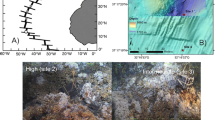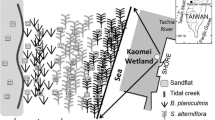Abstract
An experiment was undertaken at Farol Island, Brazil, to examine colonization of bare aluminium surfaces by microbes and meiofauna. It was hypothesized that a primary source of meiofaunal colonists was sediment resuspended during upwelling events, two of which occurred during the experiment. Microbial biofilms formed on the experimental substrata within 1 day, and continued to develop throughout the experimental period. Among meiofaunal groups copepods also appeared on the first day, and nematodes on the second. Meiofaunal community structure developed in three main phases: an initial phase of 2 days, characterized by low abundances of copepods; a second phase during the first upwelling period characterized by higher abundances of copepods and also by turbellarians; and a third phase from day 13 onwards characterized by relatively stable abundances of a range of taxa including copepods, cirripedes, nematodes and ostracods. Nematode assemblages also developed in three phases, but with different timings coinciding with upwelling events: an initial phase, from the beginning of the experiment to day 9, characterized by few species and low (or no) abundances; a second phase following the first upwelling characterized by moderate abundances of Chromadorina, Chromadorella, Daptonema and Euchromadora sp. 3; a third phase following the second upwelling period (from day 26 onwards) in which Daptonema disappeared and the assemblage was characterized by moderate to high abundances of Euchromadora (species 1 and 2) and Chromadorella. Although shifts in nematode assemblage structure coincided with upwelling events no evidence was found for sediments being the primary source of colonizers on the aluminium substrata, in contrast to our hypothesis.








Similar content being viewed by others
References
Abelson A, Miloh T, Loya Y (1993) Flow patterns induced by substrata and body morphologies of benthic organisms, and their roles in determining availability of food particles. Limnol Oceanogr 38:1116–1124
Atilla N, Fleeger JW (2000) Meiofaunal colonization of artificial substrates in an estuarine embayment. PSZN I Mar Ecol 21:69–83
Atilla N, Wetzel MA, Fleeger JW (2003) Abundance and colonization potential of artificial hard substrate-associated meiofauna. J Exp Mar Biol Ecol 287:273–287
Bell SS, Sherman KM (1980) A field investigation of meiofauna dispersal: tidal resuspension and implications. Mar Ecol Prog Ser 3:245–249
Buchanan RE, Gibbons NE (1974) Bergey`s manual of determinative bacteriology, 8th edn. The Willians & Wilkins Company, Baltimore, pp 1268
Chandler HE (1979) Corrosion-biofouling relationship of metals in seawater. Metal Prog 115:47–53
Chia FS, Warwick RM (1969) Assimilation of labelled glucose from seawater by marine nematodes. Nature 224:720–721
Clarke KR (1993) Non-parametric multivariate analyses of changes in community structure. Aust J Ecol 18:117–143
Clarke KR, Warwick RM, Somerfield PJ, Gorley RN (2005) Change in marine communities: an approach to statistical analysis and interpretation, 3rd edn. PRIMER-E, Plymouth, pp 171
Clarke KR, Chapman MG, Somerfield PJ, Needham H (2005a) Dispersion-based weighting of species counts in assemblage analyses. Mar Ecol Prog Ser (in press)
Clarke KR, Somerfield PJ, Chapman MG (2005b) On resemblance measures for ecological studies, including taxonomic dissimilarities and a zero-adjusted Bray-Curtis measure for denuded assemblages. J Exp Mar Biol Ecol (in press)
Clarke KR, Green RH (1988) Statistical design and analysis for a ‘biological effects’ study. Mar Ecol Prog Ser 46:213–226
Commito JA, Tita G (2002) Differential dispersal rates in an intertidal meiofauna assemblage. J Exp Mar Biol Ecol 268:237–256
Dahms HU, Harder T, Qian PY (2004) Effect of meiofauna on macrofauna recruitment: settlement inhibition of the polychaete Hydroides elegans by the harpacticoid copepod Tisbe japonica. J Exp Mar Biol Ecol 311:47–61
Danovaro R, Fraschetti S (2002) Meiofaunal vertical zonation on hard-bottoms: comparison with soft-bottom meiofauna. Mar Ecol Prog Ser 230:159–169
Da Rocha CM (2003) Efeito do substrato fital na comunidade meiofaunística associada, com ênfase aos Nematoda livres. Tese Doutorado, Universidade Federal de Pernambuco, 117 pp
Efird KD (1976) The interrelation of corrosion and fouling for metals in sea-water. Mater Performance 15:16–25
Eskin RA, Palmer MA (1985) Suspension of marine nematodes in a turbulent tidal creek: species patterns. Biol Bull 169:615–623
Fonsêca-Genevois V, dos Santos GAP, de Castro FJV, Botelho AP, de Almeida TCM, Coutinho R (2004) Biodiversity of marine nematodes from an atypical tropical coastal area affected by upwelling (Rio de Janeiro, Brazil). Meiofauna Marina 13:37–44
Gatenholm P, Holmstrom C, Maki JS, Kjelleberg S (1995) Toward biological antifouling surface-coatings – marine bacteria immobilized in hydrogel inhibit barnacle larvae. Biofouling 8:293–301
Heip C, Vincx M, Vranken G (1985) The ecology of marine nematodes. Oceanogr Mar Biol Annu Rev 23:399–489
Höckelmann C, Moens T, Jüttner F (2004) Odor compounds from cyanobacterial biofilms acting as attractants and repellents for free-living nematodes. Limnol Oceanogr 49:1809–1819
Jackson C (2003) Changes in community properties during microbial succession. Oikos 101:444–447
Jensen P (1981) Phytochemical sensitivity and swimming behaviour of the free-living marine nematode Chromadorita tenuis. Mar Ecol Prog Ser 4:203–206
Kirchman D, Graham S, Reish D, Mitchell R (1982) Bacteria induce settlement and metamorphosis of Janua (Dexiospira) brasiliensis Grube (Polychaeta): Spirorbidae). J Exp Mar Biol Ecol 56:153–163
Lopez G, Riemann F, Schrage M (1979) Feeding biology of the brackish water Oncholaimid nematode Adoncholaimus thalassophygas. Mar Biol 54:311–318
Lorenzen S, Prein M, Valentin C (1987) Mass aggregations of the free-living marine nematode Pontonema vulgare (Oncholaimidae) in organically polluted fjords. Mar Ecol Prog Ser 37:27–34
Maki JS, Rittschof D, Mitchell R (1992) Inhibition of larval barnacle attachment to bacterial films: investigation of physical properties. Microb Ecol 23:97–106
Mary A, Mary V, Rittschof D, Nagabhushanan R (1993) Bacterial-barnacle interaction: potential of using juncellins and antibiotics to alter struture of bacterial communities. J Chem Ecol 19:2155–2167
Moens T, Herman PMJ, Verbeeck L, Steyaert M, Vincx M (2000) Predation rates and prey selectivity in two predacious estuarine nematode species. Mar Ecol Prog Ser 205:185–193
Moens T, Van Gansbeke D, Vincx M (1999a) Linking estuarine intertidal nematodes to their suspected food. A case study from the Westerschelde Estuary (south-west Netherlands). J Mar Biol Ass UK 79:1017–1027
Moens T, Verbeeck L, de Maeyer A, Swings J, Vincx M (1999b) Selective attraction of marine bacterivorous nematodes to their bacterial food. Mar Ecol Prog Ser 176:165–178
Moens T, Verbeeck L, Vincx M (1999c) Feeding behaviour of a predatory and a facultatively predatory marine nematode (Enoploides longispiculosus and Adoncholaimus fuscus). Mar Biol 134:585–593
Moens T, Vincx M (1997) Observations on the feeding ecology of estuarine nematodes. J Mar Biol Ass UK 77:211–227
Moens T, Vincx M (1998) On the cultivation of free-living estuarine and marine nematodes. Helgoländer Meeresunters 52:115–139
Montagna PA (1995) Rates of metazoan meiofaunal microbivory: a review. Vie Milieu 45:1–9
Palmer MA (1984) Invertebrate drift: behavioral experiments with intertidal meiobenthos. Mar Behav Physiol 10:235–253
Palmer MA (1988) Dispersal of marine meiofauna: a review and conceptual model explaining passive transport and active emergence with implications for recruitment. Mar Ecol Prog Ser 48:81–91
Palmer MA, Gust G (1985) Dispersal of meiofauna in a turbulent tidal creek. J Mar Res 43:179–210
Prein M (1988) Evidence for a scavenging lifestyle in the free-living nematode Pontonema vulgare (Enoplida, Oncholaimidae). Kieler Meeresforsch 6:389–394
Riemann F (1986) Berichte der Abteilung: Nematodenkunde. Veröffn Inst Meeresforsch Bremerhaven 21:195–201
Riemann F, Schrage M (1988) Carbon dioxide as an attractant for the free-living marine nematode Adoncholaimus thalassophygas. Mar Biol 98:81–85
Rittschof D (1999) Fouling and natural products as antifoulants. In: Fingerman M, Nagabhushanam R, Thompson MF (eds) Recent advances in marine biotechnology, vol 3—Biofilms, bioadhesion, corrosion, and biofouling. Oxford & IBH Publishing, New Delhi, pp 245–257
Roberts D, Rittschof D, Holm E, Schmidt AR (1991) Factors influencing larval settlement: temporal, spatial and molecular components of initial colonization. J Exp Mar Biol Ecol 150:203–222
Scheltema RS (1974) Biological interactions determining larval settlement of marine invertebrates. Thalassia Jugosl 10:263–296
Skinner LF, Coutinho R (2002) Preliminary results on settlement of the barnacles Tetraclita squamosa and Chthamalus bisinuatus on a Brazilian tropical rocky shore under upwelling conditions. Invert Reprod Develop 41:151–156
Snelgrove PVR (1994) Hydrodynamic enhancement of invertebrate larval settlement in microdepositional environments: colonizing tray experiments in a muddy habitat. J Exp Mar Biol Ecol 176:149–166
Somerfield PJ, Warwick RM (1996) Meiofauna in marine pollution monitoring programmes: a laboratory manual. MAFF Directorate of Fisheries Research Technical Series, 71pp
Szewyk U, Holmstrom C, Wrangstadh M, Samuelsson MO, Maki JS, Kjelleberg S (1991) Relevance of the exopolysaccharide of marine Pseudomonas sp. strain S9 for the attachment of Ciona intestinalis larvae. Mar Ecol Prog Ser 75:259–265
Thomason JC, Hills JM, Clare AS, Neville A, Richardson M (1998) Hydrodynamic consequences of barnacle colonization. Hydrobiologia 375/376:191–201
Ullberg J, Olafsson E (2003) Free-living marine nematodes actively choose habitat when descending from the water column. Mar Ecol Prog Ser 260:141–149
Valentin JL (1984) Analyses des paramètres hydrobiologiques dans la remontée de Cabo Frio (Brésil). Mar Biol 82:259–276
Valentin J, Andre DL, Jacob SA (1987) Hydrology in the Cabo Frio (Brazil) upwelling: two-dimensional structure and variability during a wind cycle. Cont Shelf Res 7:77–88
Wahl M (1989) Marine epibiosis. I. Fouling and antifouling: some basic aspects. Mar Ecol Prog Ser 58:175–189
Walters K, Shanks AL (1996) Complex trophic and nontrophic interactions between meiobenthic copepods and marine snow. J Exp Mar Biol Ecol 198:131–145
Warwick RM, Platt HM, Somerfield PJ (1998) Freeliving marine nematodes. Part III. Monhysterids. Synopses of the British Fauna (New Series) No. 53. Field Studies Council, Shrewsbury, UK, 296pp
Acknowledgements
V.F.G. acknowledges a postdoctoral grant from the Conselho Nacional de Desenvolvimento Científico e Tecnológico (CNPq) and CAPES (Comissão de Aperfeiçoamento de Pessoal Docente). T.M. is a postdoctoral fellow with the Flemish Fund for Scientific Research (F.W.O.). P.J.S. was funded in part by the UK Natural Environment Research Council, and this work is a contribution to the core strategic research programme of the Plymouth Marine Laboratory. Parts of this work were funded by the UK Defra through project ME 3109. We thank the Instituto de Estudos do Mar Almirante Paulo Moreira for providing the necessary infrastructure for this work. F. Figueiredo and R. Valença are gratefully acknowledged for their help in sampling, N. Smol for help with nematode identifications, and V.M. Monteiro Ribas for help with identifications of ‘zooplankton’.
Author information
Authors and Affiliations
Corresponding author
Additional information
Communicated by O. Kinne, Oldendorf/Luhe
Rights and permissions
About this article
Cite this article
Fonsêca-Genevois, V.d., Somerfield, P.J., Neves, M.H.B. et al. Colonization and early succession on artificial hard substrata by meiofauna. Marine Biology 148, 1039–1050 (2006). https://doi.org/10.1007/s00227-005-0145-8
Received:
Accepted:
Published:
Issue Date:
DOI: https://doi.org/10.1007/s00227-005-0145-8




